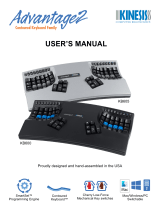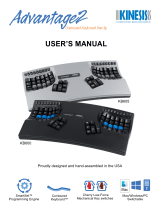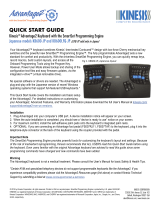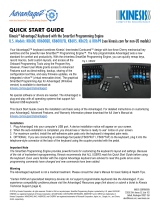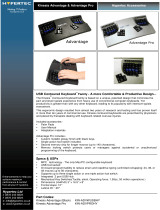Page is loading ...

1
SmartSet App User Manual - Version 1.9.5 for Windows & Mac
Overview
The SmartSet App lets you design and edit custom
layouts, build powerful macros, and customize keyboard
settings. The App works in conjunction with onboard
programming, but it has several additional tools for power
users. The App can be run from any Windows or Mac
computer and all settings are saved directly to the
keyboard for use on all Operating Systems.
Unlike conventional software, the App does not get
“installed” on your PC. Windows and Mac versions of the
SmartSet App are pre-loaded onto your Freestyle Pro for
your convenience. Note: Mac users who have upgraded
to macOS Catalina (or later) will need to download the
newer 64 bit version of the SmartSet App from our
website (link below) and run it directly from your desktop.
Unlike conventional keyboard software that uses custom drivers, the SmartSet App is driverless and does not update the
keyboard settings dynamically. Changes are implemented using the Refresh shortcut or upon disconnecting the v-Drive.
Launching the App
To launch the SmartSet App, first use the onboard shortcut to connect the v-Drive (SmartSet + F8) to your PC. When
you connect the v-Drive, your PC will now recognize the keyboard as a “Removable Storage Device” and a pop-up may
appear.
Locate the “FS PRO” drive in your file manager and then double-click either the
Windows or Mac version of the App to launch it. Note: The App can sometimes
take 10-15 seconds to launch while it reads the configuration settings so only
double-click it once.
Keep the v-Drive Disconnected When the App is Not in Use
For best results, keep the v-Drive disconnected when not the SmartSet App is not
in use and refrain from using onboard shortcuts while the v-Drive is connected.
Multimedia and mouse actions, as well as some onboard shortcuts, are disabled while the
v-Drive is connected.
Downloading a Newer Version of the SmartSet App
Periodically Kinesis will add new features or fix bugs in the SmartSet App (firmware updates may be required). The latest
versions of the SmartSet App for Windows and Mac can be downloaded from our website. MacOS version 1.9.5 of the
SmartSet App is designed to be run directly from the Desktop, not from the v-Drive. So save it anywhere on your
computer and then connect the v-Drive before launching the App to read/write to the keyboard.
Download here: www.kinesis.com/support/freestyle-pro/#smartset-app
Me
Version: April 4, 2020
File Explorer view of “FS Pro”
removable v-Drive

2
Keyboard Layout
Active Layout: When you open the SmartSet App, it will automatically load a graphical representation of the currently
active layout, showing all assigned key actions in both layers, including any custom remaps and macros. Note: The eight
default hotkeys are encoded as macros and the macros must be erased before remapping over them.
If you wish to view or edit one of the other 8 layouts, click the “Load” button at right and select it from the menu.
Remapping Key Actions
Designating the Active Key: You may “remap” (aka reassign/rebind) any supported key action
to any of the 95 full-size keys (including Fn and the 8 hotkeys). Select the key you wish to
reprogram by clicking the diagram to designate it as the Active Key. The Active Key will be
highlighted to indicate that it is currently designated for remapping (and for assigning macros).
Then type the action you would like to assign to that key on the keyboard or right-click for a drop
-down menu of Special Actions. Remapped keys are displayed with blue legends.
Navigating Layers: Each key has a “top-layer” action and a secondary “Fn-layer” action that can be
customized separately. Use the Layer toggle-switch to move between the layers during programming.
Special Actions: If you wish to assign a Special Action that isn’t found on the Pro by default, click the
“Special Actions” button (or right-click the active key to open the Special Actions menu) and select
from the drop-down menus of supported USB keyboard actions.
Cancel/Done: Once you have the desired key action, click the “Done” button to store that Remap or
click the “Cancel” button to revert back to the previously stored action. If you navigate away from the
active key your last input will be stored as the new key action.
Reset: If at any time you make a mistake or just want to start over, click one of the three Reset
buttons. Note: If you accidentally perform a Reset operation, simply Exit the App without saving your
changes to revert back to your original layout.
Dynamic Remap Count: For your convenience, the App automatically tracks how many of the 190
key positions (95 keys x 2 programmable layers) have been remapped. Each time you make a remap
you’ll see the count change.
W is the Active Key.
E remapped to perform C.
Top Layer is Active
Menu

3
Programming Macros
Trigger Key(s): To program a macro, first click on one of the full-size, non-modifier keys in the layout image to act as
your primary trigger key (Note: macros can be assigned to trigger keys in both layers using the Fn toggle switch). Once
you have selected a valid trigger key, the Macro Programming Region will become active (shown below). Macros can be
triggered solely by the primary trigger key or as a 2-key combination using a modifier key. To designate a modifier “co-
trigger”, click one of the gray “co-trigger” buttons. Note: Using the Windows key as a co-trigger is not recommended.
Macro Content: After selecting the trigger key(s), click inside the macro text box and type your macro content. The App
will record every single keystroke from the keyboard so if you make a mistake, you’ll need to use the “Backspace” or
“Clear” buttons in the App to edit. Basic alphanumeric characters are displayed in black text whereas “key actions” are
displayed as red text inside of curly brackets as “tokens”. Once you are done programming your macro, click “Done” to
assign it to the trigger key(s) or click “Cancel” to abandon the macro. Note: The timing of keystrokes is not recorded but
you can insert delays manually using the Special Actions menu as described below.
Special Actions: With the Special Actions button you can assign a pre-programmed macro (e.g., Cut, Copy, Web
Home), a custom Windows key combination or a mouse double-click. You can also insert brief delays into a macro to
improve playback performance or timing. Delays are available in 125 and 500 millisecond increments and they can be
sequenced to achieve delays of various durations.
Multiple Macros per Key: If you wish to assign a 2nd or even 3rd macro to the same primary
trigger key (e.g., Right Ctrl+A, Right Shift+A, and Right Alt+A), simply re-select that primary trigger
key and then click the “#2” or “#3” radio buttons to get access a fresh macro text box. To store the new macro you will
need to select a unique trigger key combination using one of the six standard modifiers as a co-trigger.
Copy & Paste: You can copy your favorite macros from one trigger key to another or between different layouts.
Individual Playback Speed: By default, all macros will playback at the keyboard’s “Global Speed”
setting. The Global Speed setting can be adjusted using the onboard shortcut (SmartSet + F9, then
number row) or using the “Global Macro Speed” slider under Settings (discussed below). However, to
achieve optimal playback performance for each macro we recommend using the individual macro
“Playback Speed” slider in the App to assign a custom playback speed specifically tailored to each macro and its
intended playback environment, and not rely on the Global Speed setting.
Multiplay: All macros recorded onboard will playback continuously while the trigger key(s) are held. However, the
“Macro Multiplay” slider in the App can be used to pre-program a macro to playback a specific number
of times (1 to 9) thereby overriding the repeat feature. We recommend setting the Multiplay slider to “1”
unless you know you want the macro to fire repeatedly. A Multiplay value of 1 prevents the macro from
inadvertently playing back multiple times (and producing unintended results) when the macro is played
faster than you can physically release the trigger key(s).
Seng Speed1 Speed2 Speed3 Speed4 Speed5 Speed6 Speed7 Speed8 Speed9
AconsPerSecond 4 8 12 22 35(default) 62 85 125 250
WordsPerMinute 48 96 144 264 420 744 1,020 1,500 3,000
*Playback speeds are approximate. Exact speeds will depend on the length of the macro, your computer, and the application.

4
Customizing Keyboard Settings
These Settings are adjusted universally and are not layout-specific.
Global Macro Speed: This slider controls the playback speed for all macros that don’t have an
“Individual Playback Speed” assigned to them. Turn it up to “9” for blazing fast macros or down to “1”
for slow, measured macros. Slide it all the way to “0” to temporarily disable all macros without deleting
them from any layout.
Status Report Speed: The Status Report is a convenient utility that prints-to-the-screen the most
important keyboard settings using the onboard shortcut SmartSet + F7. Just make sure you have a text editing program
open before you try to run a Status Report! The default Status Report playback speed is “3”, but some computers may
require a slower speed for proper playback. If your status report is “garbled”, try dropping the speed to “2” or even “1”. If
you are worried about accidentally triggering the Status Report, just slide it to “0” to deactivate the Status Report.
Saving and Implementing Changes
Load: Layout 1 is pre-configured for QWERTY Windows. Layout 2 is pre-configured for Mac .
Layout 3 is pre-configured for Dvorak. Layouts 4-9 are also pre-configured for QWERTY
WINDOWS. Each of these layouts can be fully customized to suit your preferences.
Save/Save As: Before exiting the App, it is necessary to Save your changes. If you wish to save
your remaps and macros to a different layout position, use the “Save As” button and select one of
the 9 positions from the drop-down menu. Note: Be careful not to over-write a layout position you
have already customized. The Save As button also allows you to save “backup” layouts to the v-
Drive using descriptive names. Note: Backup layouts cannot be loaded until they are first assigned
to one of the 9 layout positions.
Implementing Changes: The keyboard is not dynamically updated by the App and saving your changes via the App
alone is not sufficient to implement them to the keyboard. There are two easy ways to implement your changes:
1) Refresh Shortcut: If you wish to preview your changes while leaving the App and v-Drive open, simply use
the Refresh shortcut (SmartSet + Layout). The LED’s will flash 4 times and the keyboard will implement all
changes made to the active layout and settings.
2) Disconnecting the v-Drive: If you are satisfied with your changes and are done using the App, click the save
button, close the App, eject the drive in your O/S (via right-click), and then finally use the onboard shortcut
(SmartSet + F8) to disconnect the v-Drive and return the keyboard to normal operating mode.
Note: If you were editing a layout other than the active layout, you will need to designate that layout as the new active
layout separately, either using the Layout Key (Layouts 1-3) or the onboard shortcut (SmartSet + 1-9)
Support, Troubleshooting Tips, & FAQs
System Requirements: Windows 7+ or macOS 10.6+. Minimum display resolution of
1152x864. Note: App may not display properly on ultra high-definition monitors.
Do not delete or modify the folders on the v-Drive. Doing so could compromise the ability of
the SmartSet App to identify and save layouts and keyboard settings.
If the App fails to launch, try re-plugging the keyboard, performing a Hard Reset (backup any custom layout files
first), or downloading a fresh copy of the App and saving it to the v-Drive or running it from the desktop.
Visit www.kinesis.com/support/freestyle-pro/ for Troubleshooting Tips, FAQs, instructional videos, user manuals, or
to download the latest version of the SmartSet App.
If you need technical assistance, please visit www.kinesis.com/support/contact-a-technician/ to submit a Trouble
Ticket and a trained technician will respond to you as soon as possible
.
In-App Help Menu
/





